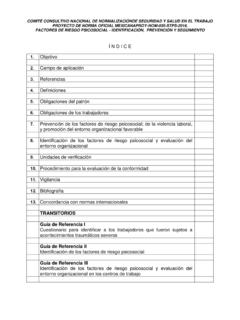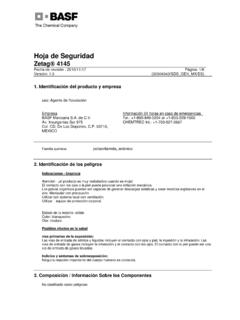Transcription of Flocculants and Coagulants: The Keys to Water and Waste ...
1 Condensed version appeared in December 1997 issue of Stone Reviewchoice is dependent on process conditions, includingvariables such as feed particle size, Water chemistry,system pH, percent feed solids, etc. This article dis-cusses some of the salient points about flocculantsand coagulants and their application in USE coagulants ANDFLOCCULANTS?Aggregate operations produce fine clay-laden slurrieswhile producing a variety of sand and gravel prod-ucts. This effluent stream is generally sent to a largeholding pond where the solids settle out and thesupernatant Water is recycled back into the Water and Waste management depends onthe efficiency of this solids/liquid separation step. Thisstep is even more critical when trying to reduce thesize of the pond or increase the settling naturally occurring fine particles, such as thoseproduced at an aggregate operation, have a negativesurface charge. This charge sets up repulsion forcesthat reduce the tendency for the particles to agglom-erate and settle.
2 However, other factors such as par-ticle size, particle density, and liquid density alsoexert considerable influence on the tendency of fineparticles to settle. Stokes law, shown below, can beused to estimate the time it takes for a free fallingparticle in a liquid to = 2g r2 (d1 d2) 9 V= final velocity of particler= radius of particled1= density of particled2= density of liquid = coefficient of viscosityg= gravitational constantINTRODUCTIONW ater conservation, efficient handling of solid wastes,and lack of space for settling ponds are some of theproblems currently faced by the aggregate problems have been exacerbated by the growthof cities and towns to the edge of aggregate producingoperations. This trend of outside town operationsbecoming within town operations will continue withthe growth of suburban areas and the growth of smalltowns and cities in most geographic areas of expanding city phenomenon has had consider-able impact on aggregate operations.
3 Not only dooperators now strive to be low cost producers, theyalso must be good neighbors to local populations whichare quickly consuming available Water and landresources. This combination of a lack of space andwater has forced many operators to change produc-tion strategies. Better Water and Waste managementplays a critical part in this strategy practice of large ponds to settle Waste solids andrecover Water has, due to the above mentioned prob-lems, given way to smaller ponds that utilize floc-culants and coagulants to effect faster settling clarity can be maintained at the same level orbetter than that of large untreated ponds. Operationsthat require even stricter control of Water and wastesolids resort to the use of clarifiers, thickeners, andbelt presses. However, all of these unit operationsrequire the use of Flocculants and coagulants for costefficient art of flocculation and coagulation has a lot more science than meets the eye.
4 A variety of flocculantsand coagulants is available, with different chemis-tries, molecular weights, charge ratios, and otherattributes. It is critical that the appropriate flocculantand/or coagulant be chosen to ensure cost effectiveperformance in a solids/liquid separation process. TheBy J. Pillai, , Nalco CompanyFlocculants and Coagulants: The keys to Water and WasteManagement in AggregateProductionReprint R-6802 Table 1 Effect of particle size on settling rateTimeParticleTotalRequiredDiameterOrd er ofSurfaceto Settle(mm)SizeArea*, cm21 foot** x x 102330 x 103550 x 104920 x 105384 x 1061050 hr**Area for particles of indicated size produced from a particle 10 mm in**diameter**Calculation based on a sphere with sg at 25 CUsing Stokes Law, settling times for particles ofdifferent sizes can be estimated and are given inTable 1. These calculations are based on a sphericalparticle with a specific gravity of at 25 expected, decreasing a particle's size reduces itssettling rate.
5 The main area of interest in the aggre-gate industry is particles in the size range of silt. Settling times are on the order of 55 minutes per footor inches per minute. Since Stokes law assumesthat the particle is settling freely, it is reasonable toexpect that in conditions such as those typical toaggregate production, some particle-to-particle inter-ference, or hindered settling, will occur, further slow-ing down the settling rate. In order to handle the samevolume of effluent in a smaller pond, settling ratesmust be increased. The only parameter that can beinfluenced, according to Stokes Law, to effect in-creased settling rates is an increase in the particlesize. By using coagulants and Flocculants , particlesizes can be increased, resulting in faster mentioned earlier, fine aggregate particles have anegative surface charge. In order to bring these par-ticles together, these surface charges need to be neu-tralized. The process of charge neutralization andbonding of particles to form microfloc particles iscalled coagulation.
6 Charge neutralization is achievedby addition of a coagulant, which neutralizes the nega-tive surface charge by its positive charge. Coagulatedparticles are then aggregated to larger particle sizesand settled by the addition of a flocculant. The co-agulation mechanism is shown in Figure of natural coagulants has been documented forover 100 years. Natural coagulants such as starch,glue, guar gum, and sodium alginate were favored inmost industrial applications early in this , these natural coagulants eventually gaveway to more cost effective, synthetic polymeric coagu-lants introduced in the early neutral and quarternized polymeric coagu-lants based on ammonia and ethylene dichloride weredeveloped by Nalco Company in the 1950s and early1960s and these displaced many of the natural co-agulants that were in use at that time. Introductionof a number of polymeric coagulants based on epichlo-rohydrin and dimethylamine in the late 1960s andearly 1970s led to a decline in the use of ammonia-and ethylene dichloride-based coagulants .
7 However,new coagulants , based on dimethyl ammonium chlo-ride, were introduced by Nalco Company in the mid1970s. The new coagulants gained rapid acceptance,and are yet some of the most widely used though coagulants based on the chemistriesabove are used in some potable Water treatment ap-plications, they are toxic to fish and cannot be usedin applications involving open Water discharge. How-Figure 1 Coagulation of fine clay particles in a slurry3ever, there are several coagulants , such as the NalcoEN/ACT product line, that have been developedspecifically for use in such applications. These prod-ucts can be safely used in applications where there isopen Water discharge or the potential for it. Severalaggregate operations prefer the use of such productseven under closed loop Water use the surface charges of particles are neutralizedand microflocs are formed, Flocculants are often addedto bring the microfloc particles together. Modern syn-thetic Flocculants have gained widespread acceptancein a number of industrial applications.
8 These prod-ucts can be, and often are, tailor-made to fit a num-ber of applications to provide a cost efficient methodof improving plant function of a flocculant is to bring together co-agulated particles into larger aggregates and settlethem. Figure 2 shows the mechanism of flocculationon fine clay typical flocculant is a long chain hydrocarbon. Thesepolymers consist of several (poly) repeating units(mer) and have molecular weights varying from 5 to20 million. Molecular weights of Flocculants aresignificantly higher than those of coagulants whichrange from 2,000 to 200, molecular weights of both coagulants andflocculants can be controlled and modified by chang-ing process variables during manufacturing. Also, avariety of different functional groups can be attachedto the backbone of a flocculant to give it different prop-erties. Thus a product can be tailor-made for specificapplications, resulting in synthetic polymers that aremuch more active than natural on its chemistry, the charge of a flocculantcan be neutral, anionic, or cationic.
9 Most aggregateoperations use neutral (nonionic) or anionicflocculants. Nonionic Flocculants are long chain poly-mers of polyacrylamides made from acrylamide mono-mer. Most Flocculants used in aggregate applicationsare copolymers of acrylamide and sodium copolymers are anionic due tothe presence of negatively charged carboxylate groupsin the polymer. The ratio of sodium acrylate toacrylamide in the polymer determines its higher proportion of sodium acrylate will result ina higher charged AFFECTING COAGULATIONThe main factors that affect coagulation are particlesize, surface charge, and Water chemistry. The smallerthe particle size, the greater total surface area perunit weight of solids, so it is not atypical to see anincrease in the dose required to coagulate fine par-ticles. This increase is not linear as small decreasesin particle size can result in dramatic increases incoagulant density of the surface charge of clay particles hasa direct bearing on coagulation.
10 As the surface chargeincreases in density, more coagulant is required forsurface charge neutralization. Care must be exercisedin coagulant addition, since over-addition couldresult in reversal of surface charge and result ininter-particle factor that is often overlooked is the chemistry ofthe Water in which particles are suspended. Dissolvedspecies such as Ca++, Mg++, Fe++ and Fe+++ help neu-tralize surface charge and can reduce the coagulantrequirements. These ions increase the conductivityof the process Water . Determining the Water conduc-Figure 2 Flocculation of coagulated fine clay particles4tivity can assist in determining coagulantdemand. Calcium and magnesium ions also determinethe hardness of the Water . A general rule of thumb isthe higher the hardness of the Water , the lower thecoagulant AFFECTING FLOCCULATIONS everal factors can affect flocculation, primarily poly-mer type, ionic strength, Water pH, slurry solids,flocculant dilution, shear, molecular weight, and pro-cess conditions.









